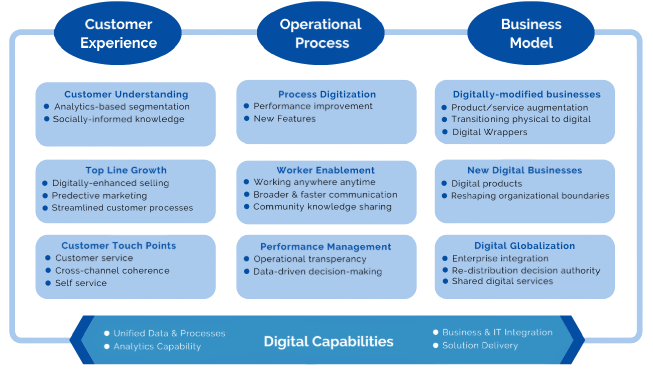
This article was first published on ITProPortal
Digital transformation is a buzzword that has become commonplace for everyone in the tech industry. Digital technology has changed the way that we view the world as well as the way that businesses function, so digital transformation has become an essential point for consideration. As times have changed, more and more companies are concluding that their methods and processes are not enough to keep their customers happy, and that’s where digital transformation comes in.
As companies look forward to the future and what it might bring from a technological and economic point of view, the process of leveraging new technologies to their full capabilities becomes more critical than ever. Digital transformation can help companies accelerate their growth and innovate on their existing processes.
What is Digital Transformation?
Digital transformation is the integration of digital technology to help transform businesses or services. Digital transformation is quite a broad term. It encompasses everything from replacing older technology with newer technology to changing how customers can interact with the company through technology and replacing manual processes with digital processes.
This holistic process encompasses all parts of the business, including internal functions like operations, finance, accounts, and external processes like customer service.
As the world changes, digital transformation is essential for all businesses to provide the best service to every customer. It focuses on creating greater value with the end consumer in mind, consisting of the stakeholders, customers, and employees. As times have changed, employees are also far more eager to work for a digitally enabled organization that has the potential to become a digital leader.
Customers are becoming more digitally connected and digitally fluent, which can translate to dissatisfaction if the business can’t match their digital fluency level. This problem can only be solved by adopting a robust digital transformation process and strategy to optimize existing processes in the company.
Digital Transformation is a people-first process that focuses on creating value through new technological innovations integrated into the day-to-day operations of a company or business. This digital transformation process also needs to factor in the various present and future changes in the technological and economic environment that may influence a digital transformation strategy.
Also read: Digital Transformation Demystified !!
Causes for Digital Transformation
- Technological Innovation: Currently, the technological landscape is evolving at a rapid pace. This includes the rise of technology that can disrupt standard business patterns and give advantages to those who find innovative ways to use this technology. Technologies like IoT (Internet of Things), AI, Blockchain, VR, and AR are all disruptive technologies that have even more potential to transform the current landscape when they converge. For example, AI, IoT, and big data analytics combined can create innovative solutions that haven’t been seen before.
- Customer Demands: Customer behavior is also changing with the rise in technology and the ease and simplicity with which it can be used. Customer demands need to be met through solutions like digital transformation. Customers are used to a certain quality of service and efficiency, and your company may need to adapt to meet their needs using digital transformation. Consumer needs need to be fulfilled, and as these tastes are ever-changing, companies need to innovate through digital transformation to give the customers benefits through convenience and quality service.
- Constant innovations and inventions: Sometimes, a completely novel innovation can change an industry and the company’s direction. If there is a new technology in the market, the company needs to keep a close eye on whether these innovations are game-changers and how important it is to adopt them early. Various innovations like medicines, trains, and the printing press have caused a complete change in the environment around businesses, so you need to be on the lookout for the next big thing for your business. Your competition in the industry will be eager to implement innovations, so your company needs to stay informed on new developments to remain at the forefront of the industry. Digital transformation is the key to staying in the competition for customer’s attention.
- Ecosystem-based innovations: Digital transformation can also be required through large-scale ecosystem-based changes. These changes may be unforeseen for the company, such as the Covid-19 pandemic; however, the company needs to overcome these challenges using new and innovative methods. Ecosystem changes can also be economic changes, a change towards collaborations in the industry, regulatory or legal changes, societal changes, or even geopolitical shifts in the external environment.

Areas of Digital Transformation
Let’s take a look at the different areas in which digital transformation can help businesses get more efficient and innovative:
- Business functions: Areas such as operations, human resources, marketing, administration, customer service, etc.
- Business processes/operations: Connected operations and activities that aim to achieve a certain business goal. Business process optimization is often a mix of external-facing goals and internal goals.
- Business models: The way businesses function can be optimized using digital transformation and searching for new and innovative revenue sources. This can even result in businesses dropping their core business in the future.
- Business ecosystem: The network surrounding the business which includes partners, stakeholders, and vendors. This network may find great value in the business’s data and intelligence and promote innovation through digital transformation. There has been a shift towards collaborative and entirely new business ecosystem approaches. This can lead to entirely new revenue sources and business models.
- Asset management: Businesses in the current landscape are increasingly focusing on intangible assets such as customers and information. Digital transformation can help companies treat these assets as real assets.
- Company culture: The employees need to be aware of the goal they hope to achieve, which can help develop core competencies. To achieve this goal, the employees need to be receptive towards digital transformation, which can provide innovations that can make their jobs easier.
- Employee, partner, and customer approaches: Digital transformation focuses on the people and strategy before the technology that is used. This ensures a people-centric approach to every process. Technology is simply an enabler to ensure that a business’s human aspects are appropriately tackled.
How has Digital Transformation helped companies?
To address consumer needs and wants
Digital transformation can help companies fulfill their customers’ needs and wants in a quick, convenient way. With an increased focus on making the customer experience better, businesses can ensure that the customers are provided with the service they deserve.
For example, Dominos has engaged in a successful digital transformation through its mobile-first digital strategy. This digital strategy included finding a better way to connect with customers through their mobile devices. This prompted them to create applications to encourage ordering through mobile devices that were intuitive and user-friendly.
This led to mobile ordering becoming the dominant revenue stream for Dominos, and this same concept was further developed to include a variety of other mobile devices, including smartwatches, smart TVs, Siri, Google Home, etc. They are looking towards investing in conversational AI and cognitive technologies to improve the user experience even more.
Reducing costs
Digital transformation is also an efficient way for companies to reduce costs, using the new innovations that have become popular in the industry. For example, companies adopt automation to help reduce the amount of time that is spent doing repetitive tasks.
Machine learning and AI is helping give employees more freedom to focus on high-level strategic tasks instead of doing manual tasks. Companies get a chance to reduce mistakes, minimize time spent on manual tasks, and decrease employees’ workload through programs, apps, and automated processes.
Costs can be cut by up to 90% by digitizing information-intensive processes. A good example of cutting costs is how GE has planned to start digitally printing turbine bases, cut down labor costs, and increase output by up to 30%.
Encouraging efficiency and innovation
Efficiency and innovation have always been drivers behind the basic processes and workflows in an organization. Digital transformation is key to driving innovation and increasing efficiency simultaneously.
A good example is the influx of project management and collaboration tools such as Slack, Asana, Trello, and the Google suite to promote better communication between employees. Typically, workers spend 28% of the workweek managing and responding to emails.
These tools make project management more efficient while reducing menial tasks, promoting new and innovative thoughts and ideas. Digitally enabled organizations have the upper hand, and every business or company must consider digital transformation as a requirement for accelerating growth in the future.
Stay competitive in the industry
Every industry is on the lookout for the next big thing, and you have to stay vigilant to stay in the competition. As consumer tastes are ever-changing, the industry needs to adapt continuously, leading to fiercer competition within the businesses in the industry.
For example, Porsche has set up a digital transformation strategy called 2025 Plus, and they have set up a special division, the Innovation Lab, to fulfill these goals. Currently, Porsche has also used digital transformation to create a central CRM for storing customer data and allotting a unique ID for every touchpoint.
Also read: 3 must-have Digital Transformation tools for Business Continuity
Essentials for Implementing Digital Transformation
Digital transformation strategy
A digital transformation strategy involves setting the agenda and roadmap for the implementation of a digital business transformation in various departments and aspects of the business. This digital transformation strategy is extremely important for the company or business to smoothly transition into new technology and more efficient processes without any problems in the long run.
A digital strategy is also crucial for attaining digital transformation’s main goals, which revolve around customer experience optimization, operational flexibility, and innovation in the digital processes and business models. A new strategy can require the revaluation of all the current strategies and processes in place.
A digital transformation is led from the top. For an organization to adapt to new digital technologies quickly and easily, strong leadership is necessary. With strong leadership, the company will have clear goals and milestones to ensure that the digital transformation process will be successful.
Leadership is also indispensable for creating a work culture that is open to innovations, methods, and processes. Leaders in businesses need to clearly articulate how a digital strategy can help build value for the end customer to help inspire confidence in digital transformation. Digital maturity is essential for a company or business to leverage digital transformation processes’ immense capabilities fully.
Digital transformation framework

As digital transformation strategies get increasingly complex, it becomes imperative for companies to have a digital transformation framework in place, which can help guide the company to transform itself through a series of clearly defined goals and objectives.
These achievable goals need to be aligned with the digital transformation strategy. These goals need to be set while considering the sheer scale and size of a business and its customers while keeping in mind their current digital maturity. This framework can help the company stay ahead of the curve when it comes to the constant innovations that emerge in the tech sphere.
The Future of Digital Transformation
As digital transformation has become progressively crucial to businesses, the need for getting acquainted with the newest digital innovations and processes has become increasingly apparent. With many companies looking towards digital transformation as the best way to improve upon current processes, time is of the essence to prevent businesses from becoming obsolete. Rapidly innovating and experimenting with new technology has become crucial to keep up with consumers’ demands.
Companies’ primary focus should be leveraging new technologies to make processes faster and operating digital-first whenever possible. Considering the sheer amount of new technology available, there’s a digital solution for every company; however, companies need to find a suitable solution that can be seamlessly integrated within the company for the problems that their customers face.
Companies are looking at the latest technologies like Hyperautomation using AI, Low-Code No-Code, RPA, IoT, and Blockchain to further meet their customer’s requirements and connect to them meaningfully while improving the employee experience. Finding ways to leverage data is also critical to help companies and businesses better serve their customers.
Going forward, new technology and innovations will be the deciding factor in the business’s overall success. Every business needs to be aware and ready to embrace new technological innovations.
The best method for businesses to go forward with digital transformation is to set up a comprehensive digital transformation strategy as well as develop a robust digital transformation framework to ensure that these changes go smoothly. To get started with a digital transformation, each business must start thinking and adopting digital processes to stay ahead of the curve.
In terms of new technology, innovative forms of development, including no-code and low-code solutions like Webflow, Air Table, Quixy etc. are becoming more popular as businesses start looking for cost-effective and efficient ways of testing and developing new websites and custom applications to help solve specific problems.
By using an intuitive visual interface that can help automate processes and build applications, a business’ growth can be aided and accelerated. In this competitive environment, not supporting your business’ growth is detrimental.
Change is the only constant in business; in this game, you need to keep rolling the die but you will not always get the same outcome. Leveraging new technologies is your next roll on the die, get a head start on it now to keep your game going.
Quixy is a no-code platform that has the capabilities to create apps that are suited to your exact needs. With a clear visual interface and an easy drag and drop builder, Quixy can help with all your business process management needs. Don’t miss out on the chance to elevate your processes. Take the first step and get started with Quixy today.
Login
Please login to comment
0 Comments
Oldest
















